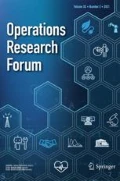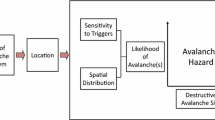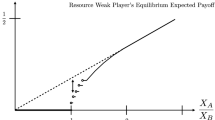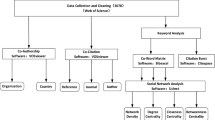Abstract
In this paper, we construct a novel game theory model for multiple humanitarian organizations engaged in disaster relief. Each organization is faced with a two-stage stochastic optimization problem associated with the purchase and storage of relief items pre-disaster, subject to a budget constraint, and, if need be, additional purchases and shipments post the disaster. The model integrates logistical and financial components, in that the humanitarian organizations compete for financial donations, as well as freight service provision, and each seeks to maximize its expected utility. The expected utility function of each humanitarian organization depends on its strategies and on those of the other organizations, and their feasible sets do, as well, since the organizations are subject to common lower and upper bound demand constraints. The governing concept is that of a stochastic generalized Nash equilibrium. We provide alternative variational inequality formulations of the model and propose an algorithmic scheme, which at each iteration yields closed form expressions for the product purchase/storage/shipment variables and the associated constraint Lagrange multipliers. Numerical examples illustrate the modeling and computational framework.





Similar content being viewed by others
References
Alexander D (2002) Principles of emergency planning and management. Terra Publishing, Edinburgh
Altay N, Green GG III (2006) OR/MS Research in disaster operations management. European Eur J Oper Res 175(1):475–493
Amadeo K (2019) Hurricane Katrina facts, damage, and costs. thebalance.com, June 25. Available at: https://www.thebalance.com/hurricane-katrina-facts-damage-and-economiceffects-3306023
Barbagallo A, Daniele P, Giuffre S, Maugeri A (2014) Variational approach for a general financial equilibrium problem: the deficit formula, the balance law and the liability formula: a path to the economy recovery. Eur J Oper Res 237(1):231–244
Barbarosoglu G, Arda Y (2004) A two-stage stochastic programming framework for transportation planning in disaster response. Eur J Oper Res Society 55(1):43–53
Bazaraa MS, Sherali HD, Shetty CM (1993) Nonlinear programming: theory and algorithms. Wiley, New York
Birge J, Louveaux F (1997) Introduction to stochastic programming. Springer, New York
Chang MS, Tseng YL, Chen JW (2007) A scenario planning approach for the flood emergency logistics preparation problem under uncertainty. Transportation Research E 43(6):737–754
Coles JB, Zhang J, Zhuang J (2018) Partner selection in disaster relief: partnership formation in the presence of incompatible agencies. International Journal of Disaster Risk Reduction 27:94–108
Coles JB, Zhuang J (2011) Decisions in disaster recovery operations: a game theoretic perspective on organization cooperation. Journal of Homeland Security and Emergency Management, 8(1), Article 35
Cruz JM, Wakolbinger T (2008) Multiperiod effects of corporate social responsibility on supply chain networks, transaction costs, emissions, and risk. Int J Prod Econ 116(1):61–74
Debreu G (1952) A social equilibrium existence theorem. Proc Natl Acad Sci 38(10):886–893
Derman C, Gleser LJ, Olkin I (1973) A guide to probability theory and application holt. Rinehart and Winston, New York
Dong J, Zhang D, Yan H, Nagurney A (2005) Multitiered supply chain networks: multicriteria decision-making under uncertainty. Ann Oper Res 135(1):155–178
Dupacova J (1996) Scenario-based stochastic programs: resistance with respect to sample. Ann Oper Res 64(1):21–38
Falasca M, Zobel CW (2011) A two-stage procurement model for humanitarian relief supply chains. Journal of Humanitarian Logistics and Supply Chain Management 1(2):151–169
Fischer A, Herrich M, Schonefeld K (2014) Generalized Nash equilibrium problems - recent advances and challenges. Pesquisa Operacional 34(3):521–558
Flavelle C, Plumer B (2019) California bans insurers from dropping policies made riskier by climate change. The New York Times, December 5
Gabay D, Moulin H (1980) On the uniqueness and stability of Nash equilibria in noncooperative games. In: Bensoussan A., Kleindorfer P., Tapiero C. S. (eds) Applied stochastic control of econometrics and management science. North-Holland, Amsterdam, pp 271–294
Gossler T, Wakolbinger T, Nagurney A, Daniele P (2019) How to increase the impact of disaster relief: a study of transportation rates, framework agreements and product distribution. Eur J Oper Res 274(1):126–141
Grass E, Fischer K (2016) Two-stage stochastic programming in disaster management: a literature survey. Surveys in Operations Research and Management Science 21(2):85–100
Gutjahr WJ, Nolz PC (2016) Multicriteria optimization in humanitarian aid. Eur J Oper Res 252:351–366
He F, Zhuang J (2016) Balancing pre-disaster preparedness and post-disaster relief. Eur J Oper Res 252(1):246–256
Hoyos MC, Morales RS, Akhavan-Tabatabaei R (2015) OR Models with stochastic components in disaster operations management: a literature survey. Computers & Industrial Engineering 82:183–197
International Federation of Red Cross and Red Crescent Societies, 2019. What is a disaster? Available at: https://www.ifrc.org/en/what-we-do/disaster-management/about-disasters/what-is-a-disaster/
Kinderlehrer D, Stampacchia G (1980) An introduction to variational inequalities and their applications. Academic Press, New York
Korpelevich GM (1977) The extragradient method for finding saddle points and other problems. Matekon 13:35–49
Kotsireas IS, Nagurney A, Pardalos PM (eds) (2016) Dynamics of disasters: key concepts, models, algorithms, and insights. Springer International Publishing, Switzerland
Kotsireas IS, Nagurney A, Pardalos PM (eds) (2018) Dynamics of disasters: algorithmic approaches and applications. Springer International Publishing, Switzerland
Kulkarni AA, Shanbhag UV (2012) On the variational equilibrium as a refinement of the generalized Nash equilibrium. Automatica 48(1):45–55
Liberatore F, Pizarro C, Simon de Blas C, Ortuno MY, Vitoriano B (2013) Uncertainty in humanitarian logistics for disaster management: a review. In: Vitoriano B, Montero J, Ruan D (eds) Decision aid models for disaster management and emergencies. Atlantis computational intelligence systems, vol 7. Atlantis Press, Paris
Liu Z, Nagurney A (2009) An integrated electric power supply chain and fuel market network framework: theoretical modeling with empirical analysis for New England. Nav Res Logist 56(7):600–624
Liu Z, Nagurney A (2013) Supply chain networks with global outsourcing and quick-response production under demand and cost uncertainty. Ann Oper Res 208(1):251–289
Liu Z, Wang J (2019) Supply chain network equilibrium with strategic financial hedging using futures. Eur J Oper Res 272(3):962–978
Mete HO, Zabinsky ZB (2010) Stochastic optimization of medical supply location and distribution in disaster management. Int J Prod Econ 126(1):76–84
Muggy L, Heier Stamm JL (2014) Game theory applications in humanitarian operations: a review. Journal of Humanitarian Logistics and Supply Chain Management 4(1):4–23
Nagurney A (1999) Network economics: a variational inequality approach, second and revised edition. Kluwer Academic Publishers, Dordrecht
Nagurney A (2006) Supply chain network economics: dynamics of prices, flows and profits. Edward Elgar Publishing, Cheltenham
Nagurney A (2016) Freight service provision for disaster relief: a competitive network model with computations. In: Kotsireas IS, Nagurney A, Pardalos PM (eds) Dynamics of disasters: key concepts, models, algorithms, and insights. Springer International Publishing, Switzerland, pp 207–229
Nagurney A (2017) Response to natural disasters like Harvey could be helped with game theory. The Conversation, August, 28
Nagurney A (2018) A multitiered supply chain network equilibrium model for disaster relief with capacitated freight service provision. In: Kotsireas IS, Nagurney A, Pardalos PM (eds) Dynamics of disasters: algorithmic approaches and applications. Springer International Publishers, Switzerland, pp 85–108
Nagurney A, Alvarez Flores E, Soylu C (2016) A generalized Nash equilibrium model for post-disaster humanitarian relief. Transportation Research E 95:1–18
Nagurney A, Daniele P, Flores EA, Caruso V (2018) A variational equilibrium network framework for humanitarian organizations in disaster relief: effective product delivery under competition for financial funds. In: Kotsireas IS, Nagurney A, Pardalos PM (eds) Dynamics of disasters: algorithmic approaches and applications. Springer International Publishers, Switzerland, pp 109–133
Nagurney A, Ke K (2006) Financial networks with intermediation: risk management with variable weights. Eur J Oper Res 172(1):40–63
Nagurney A, Masoumi AH, Yu M (2015) An integrated disaster relief supply chain network model with time targets and demand uncertainty. In: Regional science matters: studies dedicated to Walter Isard, P Nijkamp, A Rose, K Kourtit, Editors. Springer International Publishing, Switzerland, pp 287–318
Nagurney A, Nagurney LS (2016) A mean-variance disaster relief supply chain network model for risk reduction with stochastic link costs, time targets, and demand uncertainty. In: Kotsireas IS, Nagurney A, Pardalos PM (eds) Dynamics of disasters: key concepts, models, algorithms, and insights. Springer International Publishing, Switzerland, pp 231–255
Nagurney A, Qiang Q (2009) Fragile networks: identifying vulnerabilities and synergies in an uncertain world. Wiley, Hoboken
Nagurney A, Qiang Q (2020) Quantifying supply chain network synergy for humanitarian organizations. IBM Journal on Research and Development 64(1/2): (January/March), pp 12:1–12:16
Nagurney A, Salarpour M, Daniele P (2019) An integrated financial and logistical game theory model for humanitarian organizations with purchasing costs, multiple freight service providers, and budget, capacity, and demand constraints. Int J Prod Econ 212:212–226
Nagurney A, Yu M, Besik D (2017) Supply chain network capacity competition with outsourcing: a variational equilibrium framework. J Glob Optim 69 (1):231–254
Nagurney A, Yu M, Qiang Q (2011) Supply chain network design for critical needs with outsourcing. Pap Reg Sci 90:123–142
Nash JF (1950) Equilibrium points in n-person games. Proceedings of the National Academy of Sciences USA 36:48–49
Nash JF (1951) Noncooperative games. Ann Math 54:286–298
NOAA (2017) Billion-dollar weather and climate disasters: overview. Available at: https://www.ncdc.noaa.gov/billions/
Pierre-Louis K (2018) The billion-dollar natural disasters set a U.S. record in 2017. The New York Times, January 8
Qiang P, Nagurney A (2012) A bi-criteria indicator to assess supply chain network performance for critical needs under capacity and demand disruptions. Transportation Research A 46(5):801–812
Rawls CG, Turnquist MA (2010) Pre-positioning of emergency supplies for disaster response. Transportation Research B 44(4):521–534
Rodriguez-Espindola O, Albores P, Brewster C (2018) Dynamic formulation for humanitarian response operations incorporating multiple organisations. Int J Prod Econ 204:83–98
Saberi S, Cruz JM, Sarkis J, Nagurney A (2018) A competitive multiperiod supply chain network model with freight carriers and green technology investment option. Eur J Oper Res 266(3):934–949
Salmeron J, Apte A (2010) Stochastic optimization for natural disaster asset prepositioning. Prod Oper Manag 19(5):561–574
Seaberg D, Devine L, Zhuang J (2017) A review of game theory applications in natural disaster management research. Nat Hazards 89:1461–1483
Shapiro A, Dentcheva D, Ruszczynski A (2009) Lectures on stochastic programming: modeling and theory society for industrial and applied mathematics. Philadelphia, Pennsylvania
Snyder LV (2006) Facility location under uncertainty: a review. IIE Trans 38(7):547–564
Toyasaki F, Wakolbinger T (2014) Impacts of earmarked private donations for disaster fundraising. Ann Oper Res 221:427–447
US News & World Report (2018) 10 of the deadliest natural disasters in 2018. Available at: https://wtop.com/world/2018/11/10-of-the-deadliest-natural-disasters-in-2018/
Yu M, Cruz JM, Li D (2019) The sustainable supply chain network competition with environmental tax policies. Int J Prod Econ 217:218–231
Zhuang J, Saxton G, Wu H (2014) Publicity vs. impact in nonprofit disclosures and donor preferences: a sequential game with one nonprofit organization and N donors. Annals of Operations Research 221(1):469–491
Acknowledgments
The authors are grateful to the two anonymous reviewers and to the Editors for helpful comments and suggestions on earlier versions of this paper.
Author information
Authors and Affiliations
Corresponding author
Ethics declarations
Conflict of Interest
The authors declare that they have no conflict of interest.
Additional information
Publisher’s Note
Springer Nature remains neutral with regard to jurisdictional claims in published maps and institutional affiliations.
Rights and permissions
About this article
Cite this article
Nagurney, A., Salarpour, M., Dong, J. et al. A Stochastic Disaster Relief Game Theory Network Model. SN Oper. Res. Forum 1, 10 (2020). https://doi.org/10.1007/s43069-020-0010-0
Received:
Accepted:
Published:
DOI: https://doi.org/10.1007/s43069-020-0010-0




